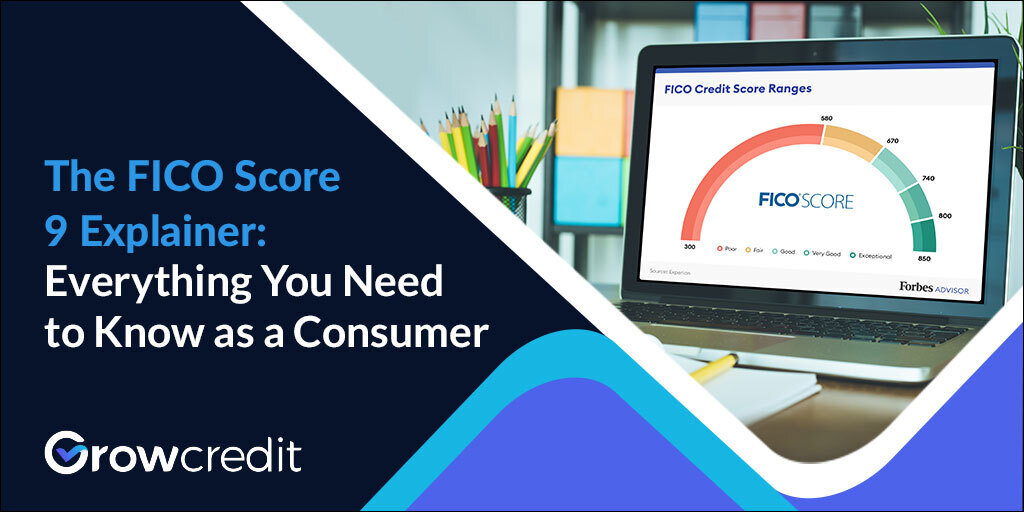The FICO Score 9 Explainer: Everything You Need to Know as a Consumer
Your FICO credit score is a big deal. No matter if you’re applying for a home mortgage, car loan, or a personal loan, it’s usually your FICO credit score that determines whether you’ll qualify or not—and then if you’re eligible, what kind of deal the lender could supply you with.
But past these basics, how much do you know about FICO as a credit scoring model? What if I said the words “FICO Score 9”—would you understand what I was talking about? And do you know how FICO Score 9 differs from, say, FICO Score 8 or FICO Score 10?
If not, don’t sweat it—this post has been tailor written for credit- and finance-curious folks wanting to learn more about the nuts and bolts of FICO, and FICO Score 9 specifically.
In this latest Grow Credit blog post, we’ll start by quickly recapping what FICO (and a FICO credit score) is in case any readers don’t know—or would just like their memories refreshed—before looking at what, exactly, FICO Score 9 is, what makes it different from previous credit scoring models, and how it’s being used by lenders so far. Additionally, we’ll provide handy info like how to know what your FICO 9 score is, and how to improve it, too.
Just read through these sections to get familiar with FICO and FICO Score 9:
What is FICO?
What is a FICO credit score?
What is FICO Score 9—and how does it differ from FICO’s previous credit scoring models?
How to find (and know) your FICO 9 score
How consumers can improve their FICO 9 score
Improve your credit score today with Grow Credit!
Let’s get learning.
What is FICO?
FICO (formerly known as Fair, Isaac and Company) is a data analytics company that was founded in 1956. In 1958, the company created their first credit scoring system, which they began distributing to a selection (around ~50) of U.S.-based lenders.
In 1989—three years after the company went public on the New York Stock Exchange—the company developed the FICO credit score: a data-based, numerical method of determining how responsible individuals are when it comes to credit usage.
FICO scores are still used to this day by lenders, helping them to see whether applicants are essentially trustworthy or not. In fact, it’s claimed that FICO credit scores are used in 90% of credit-related decision-making in the U.S.
What is a FICO credit score?
As briefly touched on in the above paragraph, a FICO credit score is a specific number that reflects your credit-related actions based off of your credit reports. It’s this that the majority of lenders scrutinize when you apply for credit—like a student loan to cover university fees which you’ll pay back when you land a job, or a home mortgage to help you buy a place from a real estate company when you don’t have all the funds to cover an outright purchase.
The FICO credit score scale currently ranges from 300 to 850. There are certain brackets that divide it up, though—i.e. there’s not just a “poor” score and an “excellent” score, as there are many in-between brackets you could fall into, like “fair,” “good,” and “very good.”
These are the current brackets and their corresponding number ranges:
300-579 = “poor”
580-669 = “fair”
670-739 = “good”
740-799 = “very good”
800-850 = “excellent”
Over time—and if there’s a concerted effort to better your score—your FICO credit score can increase. This means you can jump from a “poor” score of, for instance, 400, to one that’s “very good,” like a 750 credit score. Similarly, your score can also go downward, meaning you don’t retain a “very good” score if you then make bad credit choices after you’ve reached that specific bracket.
FICO credit scores, then, are subject to change, and are dependent on your own, individual actions. But think of this as a positive thing rather than something negative. If your FICO credit score isn’t where you want it to be, there’s always the opportunity to improve it! (This is something we’ll touch on later in the post, too.)
What is FICO Score 9—and how does it differ from FICO’s previous credit scoring models?
Now, here’s when things get a tad trickier. But let’s try to explain things as plainly as possible: there’s no one uniform FICO credit scoring model that’s used to calculate scores—there are, as of writing, 10 FICO credit scoring models in total. They are known—and written—as “FICO Score 2,” “FICO Score 4,” etc, or simply just as “FICO 2,” “FICO 4,” and so on.
To elaborate further, each FICO credit scoring model determines credit scores slightly differently, and it’s been stated by CNBC that FICO Score 2, 4, and 5 are commonly used by banks when it comes to home mortgages. But for auto loans and card lending for instance, FICO Score 8 is the wider used model according to ValuePenguin—at least for now it is.
It can take a long time before lenders and credit decision-makers switch to a newer credit scoring model released by FICO. This brings us nicely onto FICO Score 9...
FICO Score 9 is a credit scoring model introduced to lenders in 2014 and consumers in 2016. It’s the second-latest FICO credit scoring model, as 10 was introduced in early 2020. What makes FICO Score 9 particularly interesting, though, are the changes when it comes to paid collection accounts, unpaid medical accounts, and home rental payments:
Paid collection accounts: With FICO Score 9, collection accounts that are defined as paid in full on credit reports are now discounted in credit score calculations.
Unpaid medical debt: According to CNBC again, 32% of American workers have medical debt. In light of medical-related borrowing—and after discovering that unpaid medical debt isn’t as much of a credit risk alarm like credit card debt is—FICO Score 9 weighs unpaid medical debt differently—i.e. not as severely.
Home rental payments: As long as your landlord reports your rental payment history, the rent you pay each month can become a part of the mix that goes toward your credit score calculation. If you’re paying rent in full and on time, this is good news, as it gives you as a renter an opportunity (as long as the landlord obliges with reporting your rent payment history, of course) to alter your credit score—hopefully for the better. Previously, FICO didn’t take into account rental history when calculating credit scores.
Ultimately, FICO Score 9 includes what the folks at FICO call “enhancements” to make sure this credit scoring model is as predictive as possible when it comes to credit scores.
For certain people, such as those with thin credit files, FICO Score 9 could be an improvement on the previous models, as the rental payment consideration in particular could help boost credit files and even scores. The potential downside however is that it requires the cooperation of a landlord, who may not be interested (for whatever reason) in reporting your payment history.
There’s no real conclusion on what the next majorly adopted FICO credit scoring model will be. It could be 9, or it could be 10—or even whatever will come after 10. But seeing as different FICO credit scoring models are used for different things, knowing how FICO Score 9 works will certainly be useful if any of your future lenders use it.
How to find (and know) your FICO 9 score
Earlier, it was mentioned in this post that FICO Score 9 was “introduced to lenders in 2014 and consumers in 2016”—let’s elaborate on the latter part. In 2016, consumers at large were allowed to access and view their credit scores that the FICO 9 credit scoring model had calculated.
Today, it’s still possible to find and know your FICO 9 score, and you have a few ways to go about it:
By getting your score directly from FICO themselves at myFICO.com. This, however, costs you money.
Lenders—like credit card companies—often offer free credit score checks to their customers, to help them stay up to date with their credit scores. However, before doing this, double-check whether the score you’re getting is indeed from the FICO 9 credit scoring model, or whether it’s a score calculated from another FICO credit scoring model, or even from the likes of VantageScore. (It’ll vary on a lender-by-lender basis.)
How consumers can improve their FICO 9 score
Want a “good,” “very good,” or even “excellent” credit score? Well, here’s some good (pun intended!) news. No matter if your lenders are using FICO Score 2, 8, or 9—or a mix of these and others—as long as you stick to established consumer best practices, you’ll gradually get a better credit score when a FICO credit score model assesses you.
Essentially, it all boils down to:
Paying (and repaying) fully and on time. Your credit score is severely impacted when you don’t pay bills on time—and the later it’s paid back, the worse the damage is. 35% of your FICO credit score is influenced by your payment history, so it’s imperative to pay back fully, and on or before the deadline. To make it easier for yourself, automate the payment of recurring bills and subscriptions, so you don’t have to lift a finger.
Minimizing credit utilization, and owing back as little as possible. It’s not a good idea to constantly use all the credit available that’s to you—it’ll appear as if you’re financially in over your head. Instead, try to use 30% or less of your available credit. By continually using 30% or less, you can actually improve your overall credit score, too.
Having a credit mix. If you have a mix of different types of credit (say, a student loan and a handful of retail accounts that are paid on time and in full), it’ll show that you’re capable of managing various types of credit, which will naturally bump up your credit score.
Being careful with opening credit accounts. Just like how utilizing a lot of available credit can be detrimental, so can opening multiple new credit accounts in a short space of time—it can seem as if you pose a greater risk. So, be careful when it comes to opening new lines of credit, and avoid opening multiple in a short time frame.
Establishing a long credit history. Did you know that the length of your credit history can positively affect your credit score? Well, it does—so the sooner you get involved with the world of credit (and following the best practices), the better!
As you can see, there are various proactive things you can do to get your credit score higher and higher.
If you’re starting out in the world of credit yourself, or you’d simply like to improve your credit standing, there are additional things you can do to help you meet your credit score goals—like using Grow Credit!
Improve your credit score today with Grow Credit!
Grow Credit enables U.S. residents to easily build and maintain their credit scores over time.
Here’s how it works.
First, you apply for our virtual (and free) Grow Credit Mastercard, which is then used to pay small-scale subscription bills for Netflix, Spotify, Amazon Prime, and more. If you then pay back the money that’s advanced from your Grow Credit Mastercard in good time, your credit score can rise—even where the FICO Score 9 model is concerned.
It’s really as simple as that!
Here’s a visual explainer of how Grow Credit works in case you missed anything, or if you’d like to know more.
There are a few requirements you do need to meet to get started with Grow Credit. You need to have the following (and in your own name):
A bank account (that’s been open for at least 60 days)
A valid email address
A working phone number
A social security number
A physical U.S. address and resident status
A minimum income of $1,200 per month (for at least two months)
An account balance of at least $100
And to be age 18+
Do you meet the short list of requirements? And are you ready to grow with Grow Credit?
If you answered “yes,” to both questions, apply via our iOS app, Android app, or through our website today!







